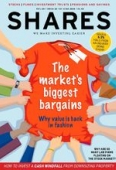Archived article
Please note that tax, investment, pension and ISA rules can change and the information and any views contained in this article may now be inaccurate.
Why the world is becoming hot on solar power

The date was 27 August 1956. The UK was in the midst of the Suez Canal crisis and rationing petrol. Black and white TVs were about to enter mass production, and folk tuning in for the inaugural Eurovision Song Contest would be disappointed, not for the first time, at the British entry.
As a sign of the post-war decline, the people of the UK had increasingly fewer reasons to be proud of their lot, but on this day, they could at least point to the nation’s pole position in the global energy race.
As Calder Hall, sited at the now Sellafield plant, plugged itself into the grid, the nuclear age had begun with the UK at its forefront.
The initial signs were encouraging. Not only was the plant capable of producing weapons grade uranium (its original purpose), the 240MWe of power on board promised cheap energy for the masses.
HYPE VERSUS REALITY
As with all new technologies, the early hype was largely overblown. With claims of progressing from nuclear fission to nuclear fusion abound, it wasn’t too long before the Windscale fire of 1957 dulled the shine of the nuclear industry despite claims from physicists that free fuel for all could be just around the corner.
Even today, those claims persist. As nuclear scientists devote billions of dollars in an attempt to fuse hydrogen together and recreate the conditions of the sun, the truth is, fusion based power is already upon us and growing rapidly.
Located roughly 93m miles away and regular as clockwork, we have access to our very own fusion reactor. Providing us with all the energy we need, the sun has the power to generate all of the electricity we could ever wish for, thanks to our understanding of photovoltaics. Yet solar power isn’t terribly efficient and the sun doesn’t always shine when you want it to.
Step forward science. Thanks to improving technologies, solar panels are becoming not only cheaper, but also much more efficient. Combined with advances in material science, the problem of electricity storage is also declining. Therefore not only can more sunlight be captured and converted, but we can now begin to distribute and use the energy at a time and place of our choosing.
SOLAR PREDICTIONS
It is still early days. Just 2% of the world’s electricity is generated via solar power, but the figure is growing rapidly and is predicted by visionaries such as Elon Musk to reach as much as 27% by 2050. Growth at that pace and in an industry with that scale points to an exciting time for investors ahead.
So how do you play the solar theme? Panel manufacturers, installers, inverters (to change DC to AC) and cabling companies will all no doubt have a role to play.
The enabling technology that will unlock not only solar but other forms of carbon-free power such as wind and tide is that of battery technology – both large scale to support industrial size solar arrays and small scale to support localised home power production.
As the motor industry transitions away from petrol to electric vehicles, it is here where some of the real advances in battery technologies are being made. When you change your perception
of the automobile from that of a mechanical horse to one of a drivable battery, maybe the auto company valuations have a little more vroom in them yet?
By Kevin Doran, managing director, AJ Bell Investments
Important information:
These articles are provided by Shares magazine which is published by AJ Bell Media, a part of AJ Bell. Shares is not written by AJ Bell.
Shares is provided for your general information and use and is not a personal recommendation to invest. It is not intended to be relied upon by you in making or not making any investment decisions. The investments referred to in these articles will not be suitable for all investors. If in doubt please seek appropriate independent financial advice.
Investors acting on the information in these articles do so at their own risk and AJ Bell Media and its staff do not accept liability for losses suffered by investors as a result of their investment decisions.
Issue contents
Big News
- BT in charm offensive to get investors back onside
- Markets are climbing the ‘wall of worry’
- Battle for control at Stobart and Petropavlovsk
- What does the Government sale of RBS stake mean for investors?
- Why Hotel Chocolat continues to be a sweet investment
- Bodycote boom time raises the fear of inevitable bust
 magazine
magazine








